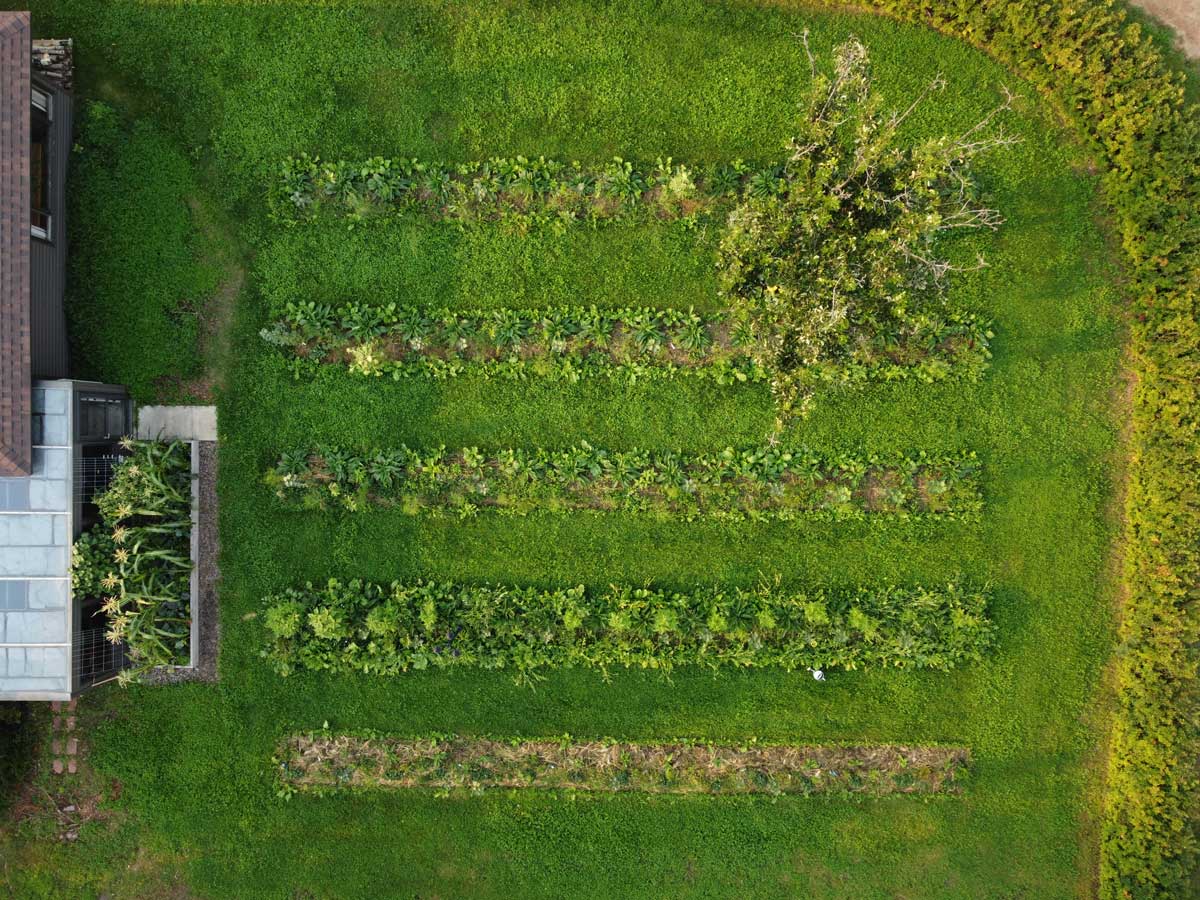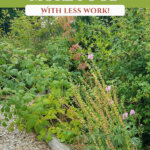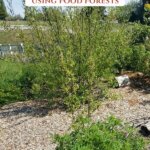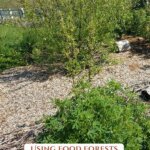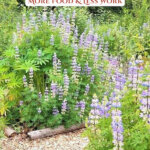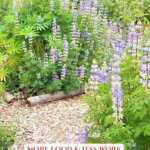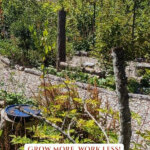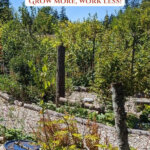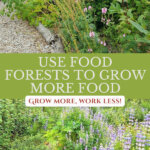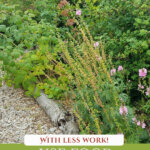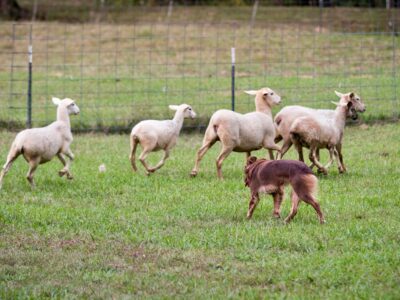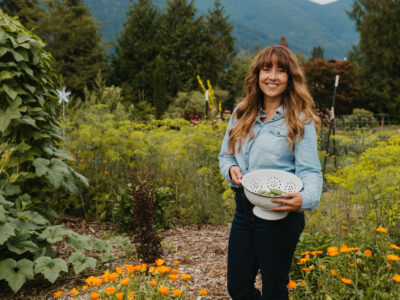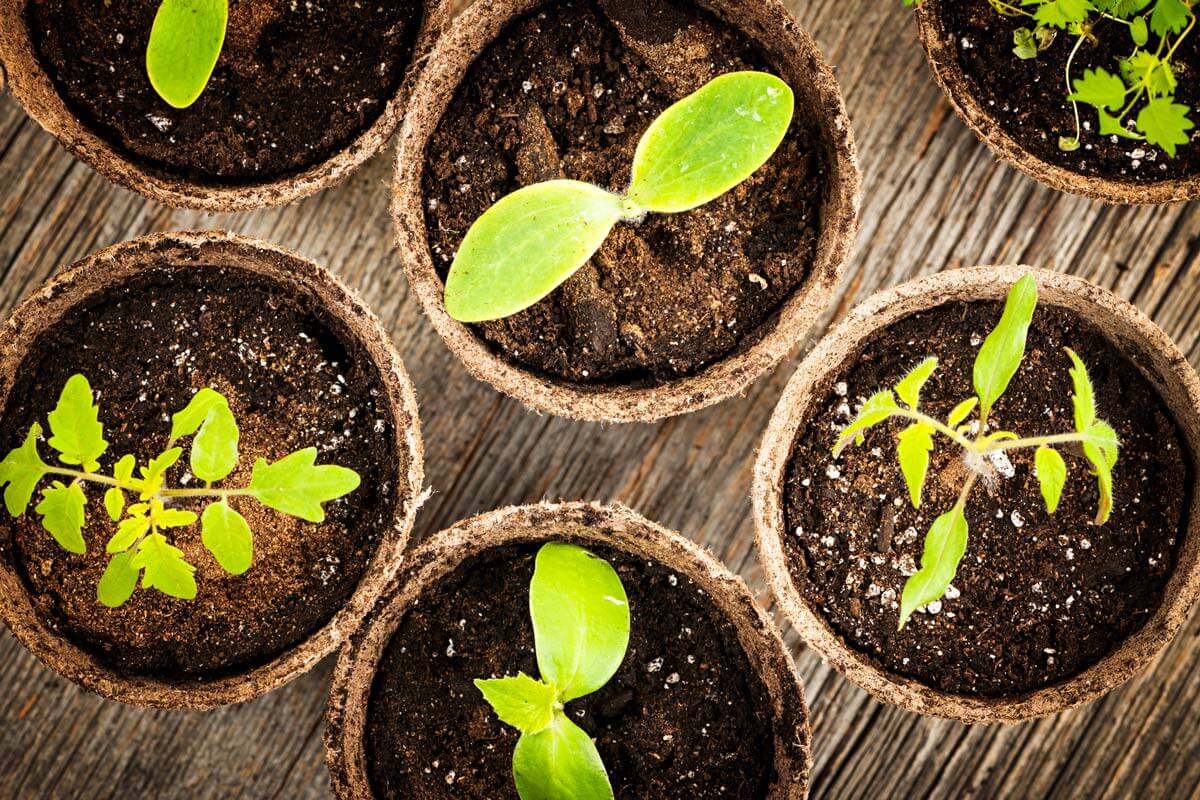Today we’re learning how we can grow MORE food with LESS work by using food forests. Including what they are, how they're restorative to nature, and how you can grow one no matter what climate or growing zone you're in.
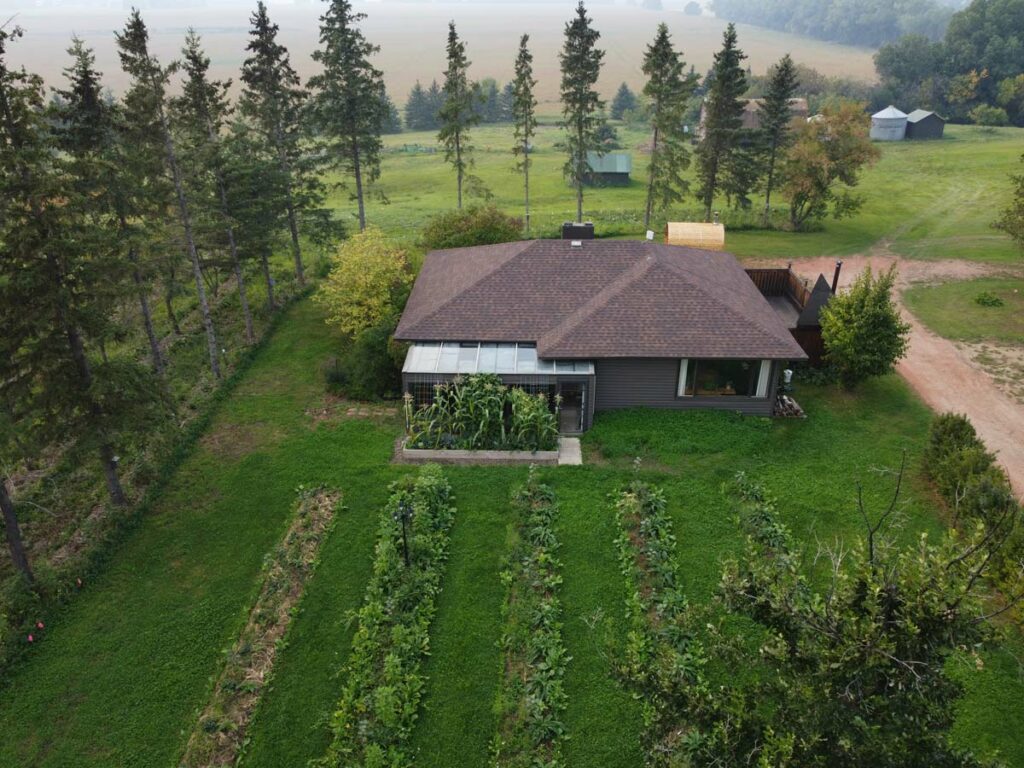
Why I Love Food Forests
The first time I heard the term “food forest,” I wasn't really sure what people meant by it. As I started to learn more about it, I learned that it combines permaculture and restoration practices for edible gardening.
A lot of food forests are designed with a perennial type structure including fruit trees and berry bushes, but they can also incorporate annual vegetables and a lot more plants than one might imagine possible. The advantage to this is, of course, increased food from your land, but it also cuts back on weeds AND naturally improves the health of your soil with less hands-on work.
This blog post was originally published to include my podcast interview (episode #296) with Daron, the founder of Growing With Nature, but has since been updated with my interview with Takota Coen of Building Your Homestead (episode #440). If you're looking to incorporate food forests into your landscape and homestead, I highly recommend listening to both episodes.
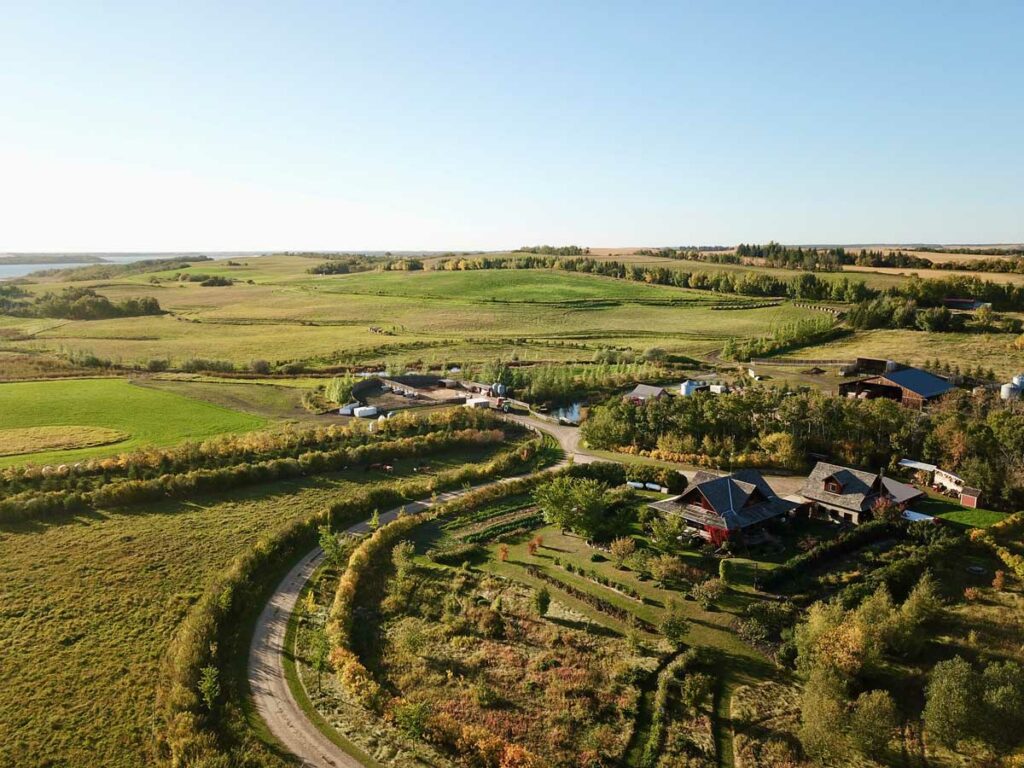
What Is a Food Forest?
Have you wondered what a food forest is? It's an agroforestry system that mimics the climax ecosystem of a forest. Most people are familiar with these systems for food, but as Dave Jacke says, they can also be used for fiber, fuel, fertilizer, fodder, pharmaceuticals and fun.
Think of it like a multispecies orchard where all of the requirements and products of each individual plant are supplied and used by other elements in the orchard.
So rather than humans indefinitely providing all the weeding, watering, fertility, pest management, and frost/wind protection, forest gardens are thoughtfully designed to facilitate their own needs and yields.
When human input is required, it is designed to be as short-term, efficient and enjoyable as possible. The ultimate goal is an agricultural system that provides yields for centuries and whose major human input is harvesting.
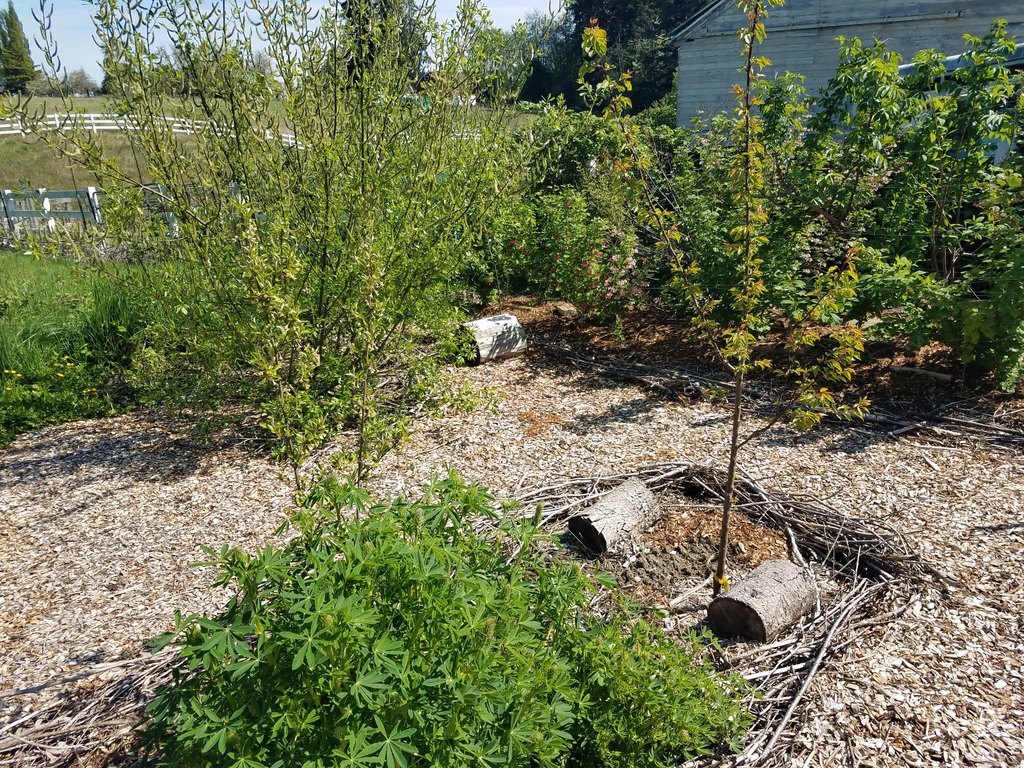
Benefits of a Food Forest Garden
There are multiple benefits of growing a food forest garden. Some of these are:
- Perennial: Plant only once and harvest for years to come. Per square foot area, they take the same amount of time and energy to establish as an annual garden but require less time and energy to maintain once established. At peak productivity, they will provide more yields per unit area than any annual system.
- Less Nutrient Requirements: Annual crops use four times more nutrients than perennials.
- Less Weeds, Diseases or Pests:
- Increased Soil Health: Forests are the climax ecosystem in most places on the planet.
- Create Their Own Microclimate: They can moderate temperature extremes (both high and low), moderate extreme drought and precipitation as well as reduce wind.
- Diversity: Throughout the year (and from year to year), they will create a diversity of yield timing. This means that you can get food from one area from the very beginning of spring all the way through (and sometimes past) the first frost in the fall.
- Beautiful:
- Less Bending Over: This can be something to consider as you age. We all want to establish our own retirement plans, right? Consider food forests as a great option for establishing your gardens for years to come without all the backbreaking work.
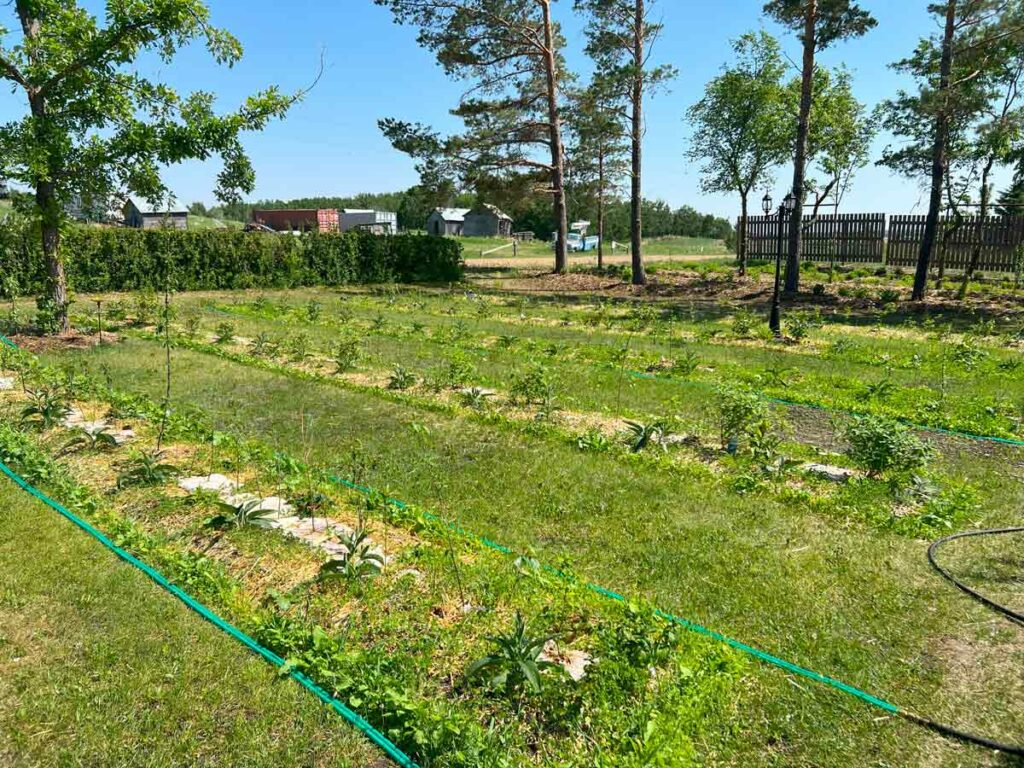
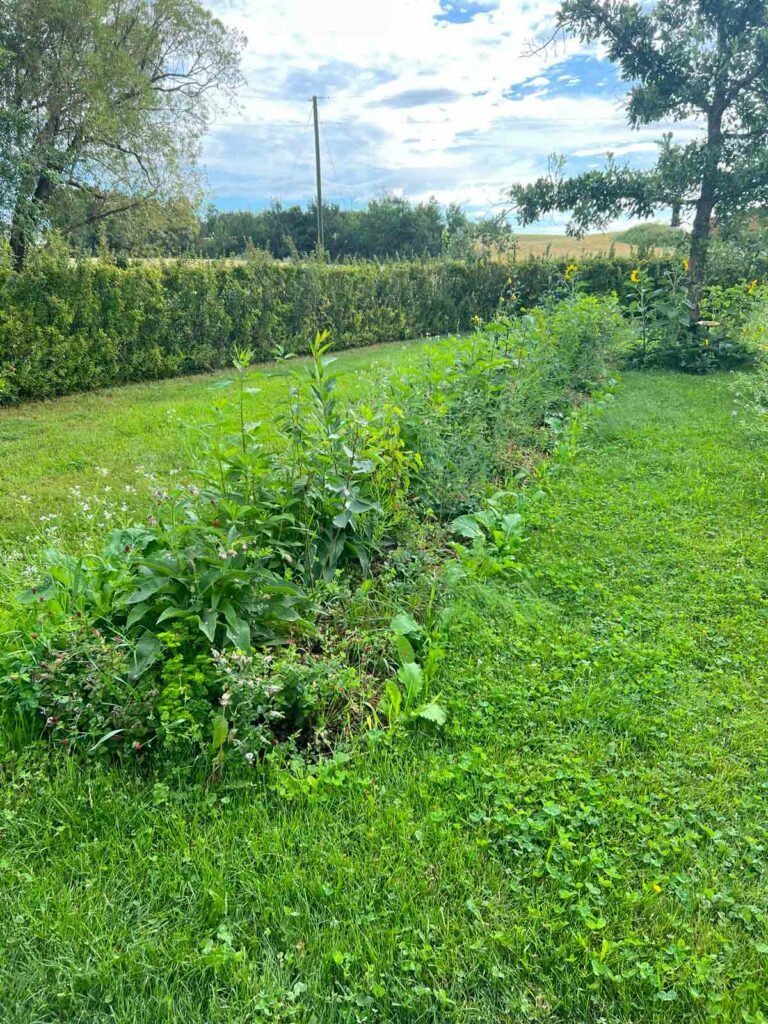
Syntropic Agroforestry vs. Food Forests
What's the difference between syntropic agroforestry vs. the typical food forests we've all heard of? Well, first of all, we're talking about entropy vs. syntropy.
- Entropy is the measure of the energy dispersal in a system. It is spent on thermodynamic energy. For example, as a campfire burns down, its entropy increases. This is modern industrial agriculture in a nutshell – with huge inputs every year, the quality and quantity of yields steadily decline over time.
- Syntropy is the measure of a system's increase in energy over time. It is increasing life energy. The universe has a tendency toward complexity, structure, order and ever-increasing life.
Ernst Goch perfectly exemplified syntropy in 1984 when he bought 1,200 acres of deforested land in Brazil. The area was known as the “Dry Land” and had the poorest soil in the region.
Within ten years, Ernst had taken the worst soils and transformed them (with no outside fertilizers or inputs other than some lime) into the best in the region.
His land now produces three times more cocoa per acre than the average cocoa farms in the region. In fact, what was once dry land, now has 17 streams that run year-round (even in droughts).
| Food Forest | Syntropy |
| Competition | Collaboration |
| Random Planting Plans | Strategic Rows (oriented north/south or contour/keyline) to optimize sunlight, water harvesting and management |
| Grass is the enemy. | Grass is the placenta that feeds the baby forest. |
| Decades before the system mimics the forest dynamic. | Months or weeks before the system mimics the forest dynamic. |
| Low density of plantings – high diversity | High density of plantings – low diversity |
| Chop n' Drop | Mulch & Organize |
| Focus on Climax Plants | Focus on Succession |
| Outcome Based | Process Based |
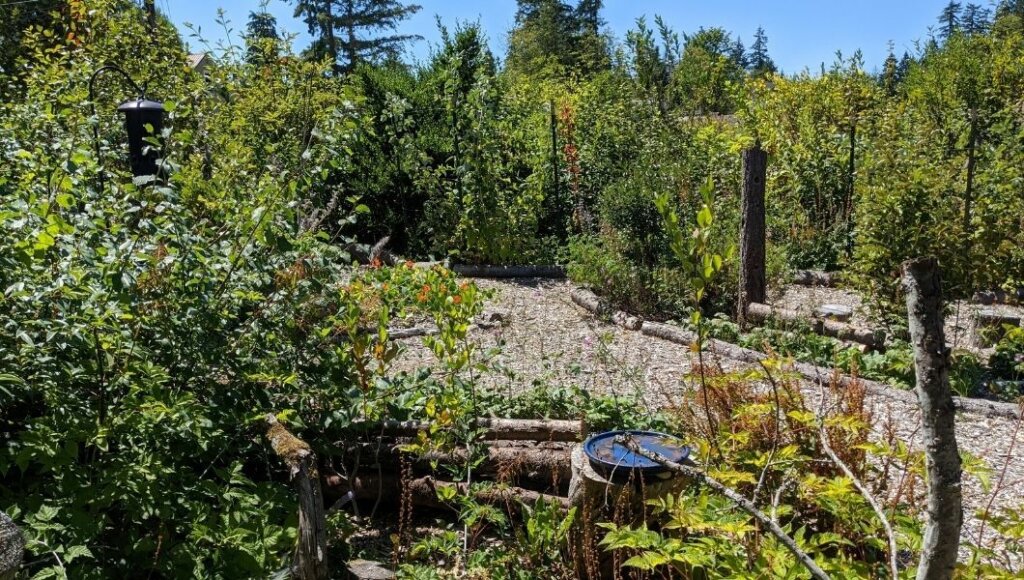
Key Principles for Productive Food Forests
- Strata – The goal is to maximize photosynthesis, cycling energy and creating a microclimate by layering your plants with high, middle and low plants. Your goal is a high leaf area index.
- Life Cycle – This is all about transferring the life energy and nutrients from one plant to another over time. Think of a relay race where the first runner hands off the baton to the next runner, and so on. As one plant grows tired, it passes off its energy to the next plant.
- Succession – Optimizing the four ecosystem processes over time: Water, nutrients, sunlight and organisms.
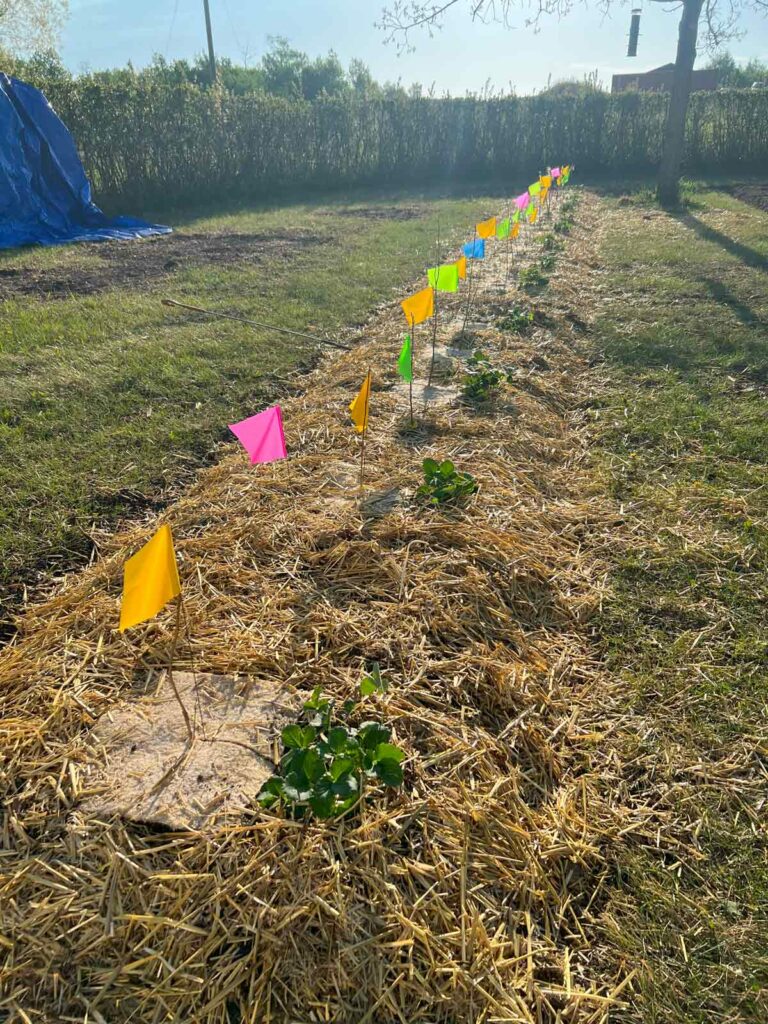
Applying These Principles to a Small Homestead
To apply these principles to a homestead, follow these examples from Takota:
- Gardens – Use the three sisters' method of planting corn, squash and beans. Use relay planting, where you plant something in right after you remove one crop. Plant cover crops to help with the strata of your garden.
- Pastures – Use annual nurse crops when establishing your pastures. Use Silvopasture methods along with rotational grazing (mob grazing). Here's information on pasture rehabilitation as well.
- Grain Crops – Use intercropping strategies, alley cropping or the method Takota shared in the podcast.
- Flower Pots – The strata is something most flower gardeners already do in a flower pot. You think about the height of the back flowers vs. the lower-growing flowers that will be in the front.
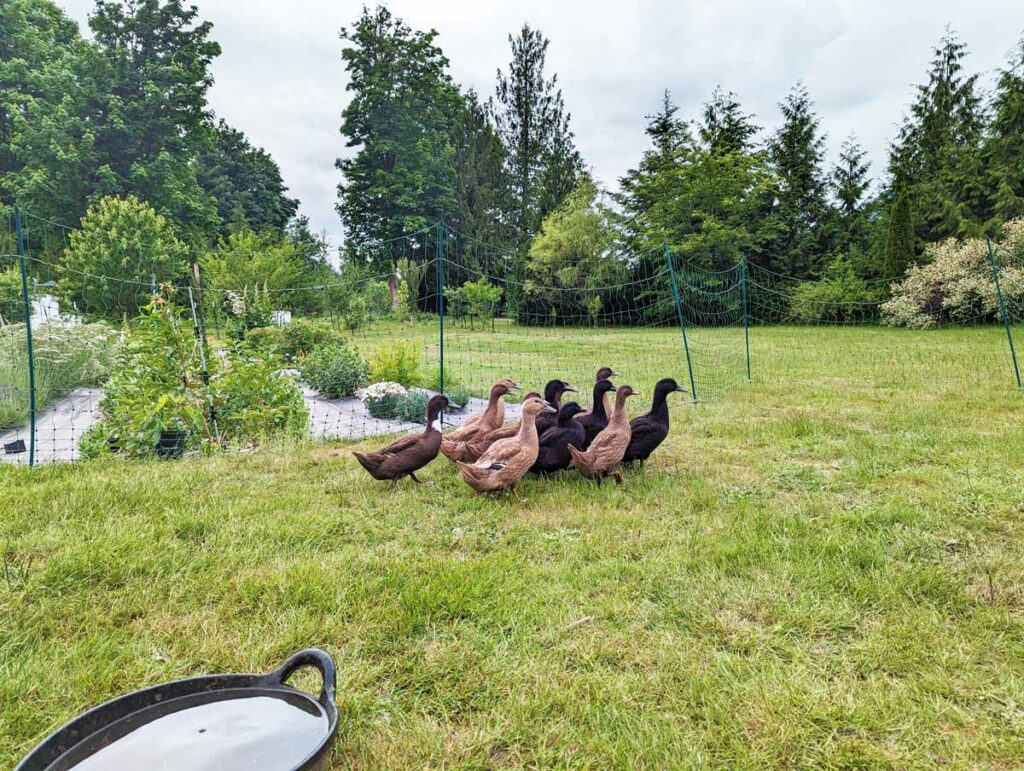
Incorporating Animals into the Food Forest System
Animals are the missing layer in all food forest models, including syntropy. Utilizing animal tractors or exclusion fencing in early years, if not indefinitely. Planting food forests for livestock, etc.
Though we've made the mistake of using chickens in the garden during the growing season, we now have ducks that help control our slug population.
Some other benefits of using animals with your food forests:
- They can upgrade low-value plant material to high-value milk, meat, eggs, fat, bones, fibers, etc.
- Livestock feed is cheaper than organic fertilizer.
- Faster cycling of nutrients/mulch, especially in brittle/dry ecosystems.
- Weed/pest control.
- Earlier and more stable yields.
- Entertainment!
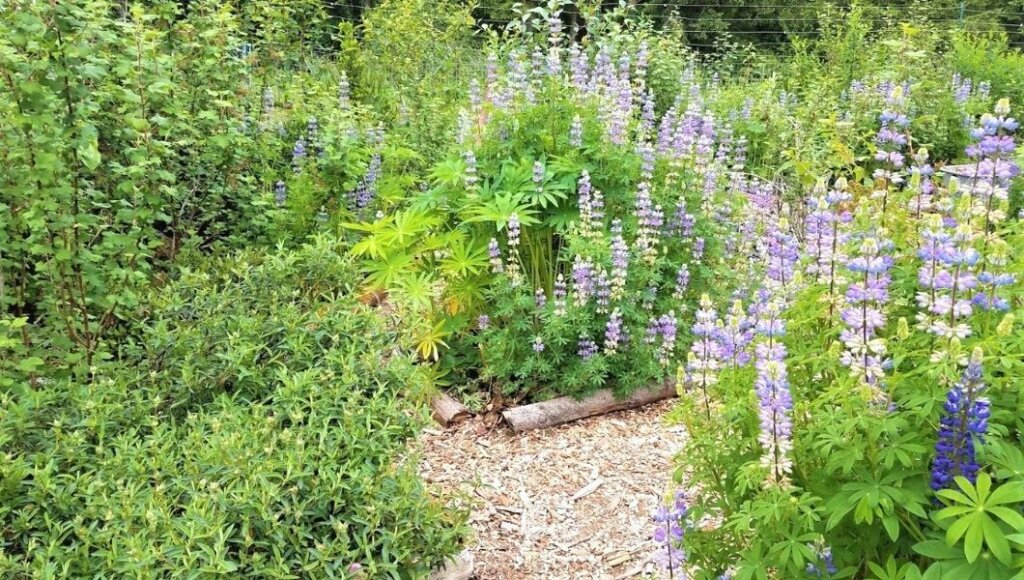
Plants to Use in Your Food Forest:
Below are the resources mentioned in the podcast episode with Daron about what plants grow well in food forests:
- Redwood Sorrel – Oxalis oregana – Shade loving native vegetable. How to Grow Redwood Sorrel.
- Woodland Strawberries – Fragaria vesca – Shade-loving strawberry native to western WA. Produces small fruit that is quite tasty. How to Grow Woodland Strawberries
- Miner's Lettuce sometimes called Claytonia – Claytonia perfoliata – Shade-loving native vegetable but can grow in the sun too. How to Grow Miner's Lettuce
- Checkermallow – Sidalcea – There are two types, Daron recommends the Henderson’s Checkermallow – Sidalcea hendersonii.
- Goumi Berries – Elaeagnus multiflora – Nitrogen-fixing shrub that's native to Asia. How to Grow Goumi Berries
- Riverbank Lupines – Lupinus rivularis – Nitrogen fixer. How to Grow Lupines (including riverbank lupines)
- Pacific waterleaf – Hydrophyllum tenuipes – Shade-loving native vegetable. How to Grow Waterleaf
- Virginia waterleaf – Hydrophyllum virginianum – Shade-loving native vegetable. How to Grow Waterleaf
- Spring Bay clover – Springbank clover – Trifolium Wormskioldii – Native nitrogen fixer with edible roots that native people use as a staple food crop. How to Grow Springbank Clover
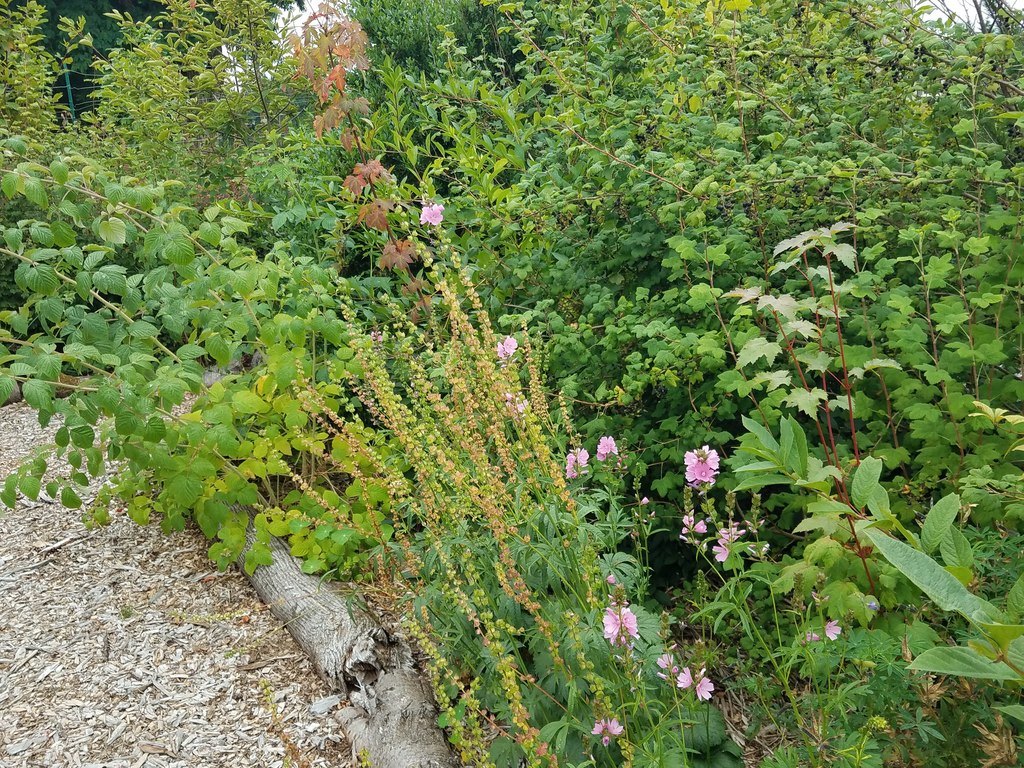
Resources:
- Building Your Homestead
- Audubon Society to find native plants for your area
- Local Conservation Districts or Soil Conservation Districts can help with native plant species.
- Growing With Nature
- Learn more about food forests and forest gardens from Bill Mollison, Geoff Lawton, and Robert Hart.
- The Permaculture Orchard by Stephan Sobkowiak
- Edible Forest Gardens by Dave Jacke & Eric Toensmeier
- Creating a Forest Garden by Martin Crawford
- Restoration Agriculture by Mark Shepard
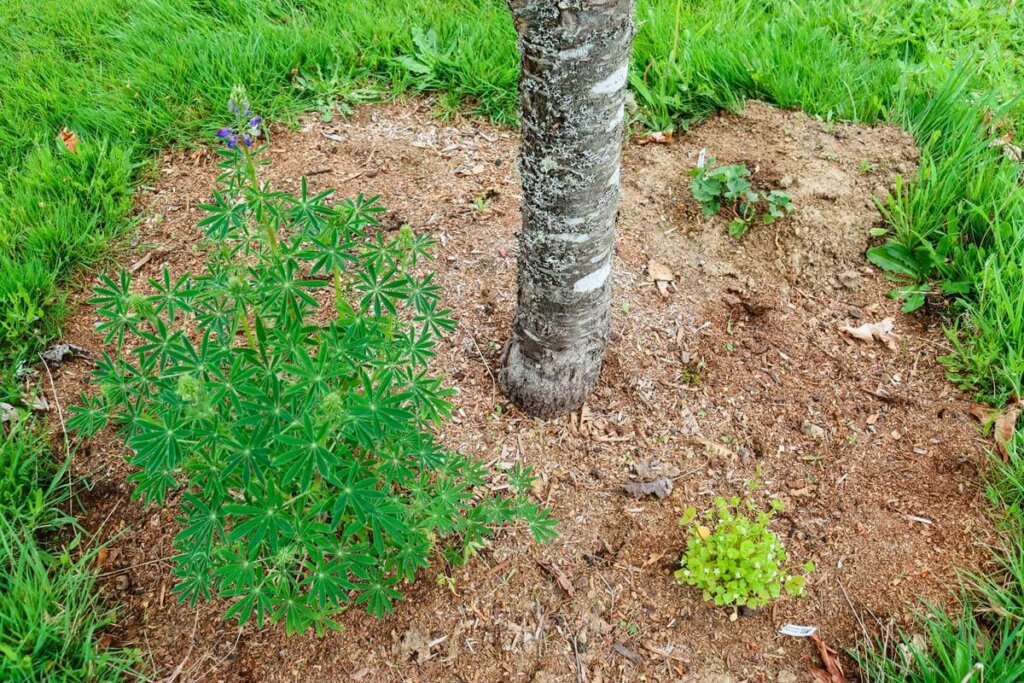
More Posts You May Enjoy
- Planting a Fruit Tree Guild
- 5 Tips for Starting an Orchard and Growing Fruit
- Orchard Planning to Keep Pests Out (Live Coaching Call)
Melissa: Hey pioneers, and welcome to episode number 296. Today's episode is going to be about how you can grow more food by creating a food forest that requires less work and uses your space wisely. So the first time I heard the term food forest, I wasn't really sure what people meant by it. As I started to learn more about it, it combines permaculture and restoration practices for edible gardening. So a lot of it is done with a perennial type structure, including fruit trees and berry bushes, but it also can incorporate regular annual vegetables and a lot more edible plants than one would think beyond just your typical fruit trees and berry bushes. So it incorporates them as well.
Melissa: So I brought in a guest expert today, and you guys, I am not kidding you. I just got done recording this episode. I literally have a page of notes and already have outlined the plants that I am going to get that I don't currently have to begin creating my food forest. So I am really excited for this episode. You can do it small scale, and you can do it large scale. So it doesn't matter if you have a small urban yard or if you have acreage and sprawling property or if you just have one single fruit tree, you're going to be able to incorporate these tips, and they are so good. I'm so excited for this episode.
Melissa: So Darren, if you're not familiar with him, is the founding owner of Growing with Nature. So it is a site that aims to make our living world come alive with abundance for people, plants, and wildlife, one property at a time, Darren holds a master's in environmental studies and an applied science degree in water resources, and he loves sharing the joy of growing food with his two beautiful children, and nothing makes him happier than seeing his kids exploring the living world around them.
Melissa: Now, even though Darren is in the same area, we're actually... Oh, goodness. We're probably about two to three hours away from one another. But he is from Western Washington. However, he gives some great tips about using native plants, even if your growing climate is vastly different than mine that you'll be able to apply. He also gives us some great lists of plants that will go and/or grow. But ideally, we want them to grow, not just go in different gardening climates. So no matter where you're at your gardening journey or what your growing climate looks like, I think you're going to get a lot out of this episode.
Melissa: Because he lists some different plants and you will actually hear me stop him and say, "Can you please spell that one for me? It's a new one." We have in today's blog post that accompanies this episode, you're going to want to go and grab all of the resources there because it is just jam packed. So you're going to want to go to melissaknorris.com/296, so just the number 296, because this is episode number 296. It'll take you straight there, and you can get all of the links and look at all of the great resources that we have accompanying this episode. So without further ado, let's jump in. Well, I am super excited to have you on the show. So Darren, welcome to the Pioneering Today Podcast.
Daron: Thank you. It's great to be here. I really appreciate you having me on.
Melissa: Yeah. So this is a subject I'm actually really excited to talk to you about because I don't have a ton of experience in it. I'm very intrigued by it, and I've had a lot of listeners and readers ask me about it. So I'm so grateful that you're going to be coming on and giving not only the listeners, but myself some tips and some education on how to begin implementing this, and let's just get right to it. What is a food forest, and how is that separate, or how is that different from having an orchard?
Daron: Yeah. So when we think about an orchard, generally, especially on a commercial side, you're looking at fields of a single type of fruit tree. Sometimes they even are bare ground underneath them. There's just a fruit tree there. Sometimes there's grass growing around them, but it's pretty basic just the fruit trees themselves, and that can work great for the commercial settings, where they use mechanized equipment to do it, all the harvesting and everything. But a food forest is looking more at like, what does a forest actually look like, and can we mimic that to grow food?
Daron: So instead of just the fruit trees, there's also going to be shrubs in there. There's going to be root crops, herbaceous plants, and what do you wants. There's climbers. In the classic food forest, there's kind of like seven layers. You got the canopy trees, the sub-canopy trees, the shrubs, those non-woody herbaceous plants and then kind of some other non woody plants, like the ground covers, like strawberries, root crops, and then the climbers going up them.
Daron: So they have the potential to really produce a lot of food because instead of just, say getting apples, you might be getting apples and berries and vegetables, a whole wide range of food from that same system. So you're mimicking a forest, but there is some challenges with that, and I think especially up here in the temperate world where we don't get as much sun as the tropics, sometimes you have to modify a food forest and design based on that.
Melissa: Okay. I'm so glad that you brought that point up, because as you were talking about the berries and the fruit trees, I'm like, "Oh, would my berries get enough sun after the fruit trees reach a certain size?" Or are you looking at when you're doing it like that? Or you're looking at some berries that perhaps do a little bit better? I live in Western Washington. I know you're in Western Washington too. Salmon berries just naturally grow very native in the forest. They don't have to be in full sun. They'll still produce et cetera. Whereas my blueberries, I'm not sure how well they would do in a more shaded environment. So do you take that into consideration, I'm assuming when you're picking the specific plants that you're going to be putting into the food forest?
Daron: Yeah. I like to break food forests into kind of like three types. I feel like each type has different pros and cons to them because a lot of times, food forest, when people picture them, they think of just a big, mature forest. Those are very shady. I think a lot of food forest examples that people see online tend to come from tropics and subtropics, where they get a lot more sun, and those forests can be a lot more productive in all the layers. So I like to break it up into three types. So one is just what I call the oak savanna type of food forest.
Daron: You have the big trees, but there's wide spaced, and you have grass or other non-woody plants growing between them. That's kind of that classic example of early cropping could be seen as this way too, where you're running animals between rows of trees, that type of system. That has a lot of light. It's kind of just like you're combining systems with that one. But it does take more maintenance than the other types. Because one of the other types that I like to think about too is what I call a recovering forest.
Daron: For this, think about a forest that just after a forest fire, for example, or a logging activity potentially, often, especially with forest fire, if it's not too intense, you're going to have some trees left standing, but it's really opened up the whole forest. But there's a lot of shrubs coming back up afterwards. So you have this mix of big trees, but they're widely spaced. But then you don't really get grasses, but you get a lot of shrubs and non-woody plants growing around them. I like that type. That actually tends to be my favorite type in our area.
Daron: Then there's also the mature forest, which is... That's what people tend to think about, and that's where you have a closed canopy. The sunlight's blocked. The mature forest type is where most of your production in our temperate environment is really going to come from fruit and nut trees. They're the ones out there getting the sun. But you could grow something, like you mentioned, salmon berries and sometimes gooseberries too, depending on how shady, and you can also raise mush or cultivate mushrooms underneath those two. You could do some get forestry products, like timber could be... You can do [inaudible 00:08:39] kind of systems like that in these.
Daron: But a recovering forest is open enough. So you might have... When I do it, I might space my fruit trees 20 feet apart or put them in clumps together and then have each clump spaced widely. Then in between them, you have a whole bunch of sun. So there you could grow the raspberries, the blueberries, especially if they're on the South side of those fruit trees, and you can kind of have that mix, and then in between those, you could even grow vegetables. I've grown all sorts of veggies, like my front food forest. I put Scarlet runner beans in there because there's a nice place that gets a little sun, and they do great there.
Daron: So you can have this nice mix. I think that's important is to know your climate and know how much sun you get and know what you want to get out of it. If you want some fruit or nuts, but you really want to have a lot of the annual veggies or the classic harvest, then you probably want the oak savanna or recovering forests where the trees are spaced out a lot more.
Melissa: Okay. That makes sense. I know when we hear the word forest, we think of very expansive, large areas. But for, like you're saying, a front yard or for doing it, that's where I have my fruit trees is just actually in our site and front yard as well, to do the system, how small of a space can you do it. Obviously, the larger it is, the more you're going to be able to do. But is there really a space where you're like, "Oh, that's probably a little bit too small type."
Daron: Yeah. You know how people think about a forest. In some ways, I think it's better to think about this that you're mimicking the structure of a forest, not necessarily the expansive nature of it. So I mean, it's great if you can do that. I'm on just under three acres, and most of it, I haven't had... My wife and I have lived on our land just over four years. So I haven't done what I want to do on all of it yet. But our main food forest is in our front yard, and four years ago, that was just lawn, and it's just about 0.06 acres or measured out as like 2,600 square feet.
Daron: So it's not very big. My other food forest is about half that size right now. But within that front food forest, for example, that's not less than 3,000 square feet, I have almost 25 types of perennial food crops growing in there, and I can add annual vegetables in there too. I'll be adding lettuce and kale biannual. But I'll be adding some nutritional veggies in there too. So during the main time of the year, I can get probably up to 30 to maybe even 40, depending how many veggies I put in on types of food crops in that one small area.
Melissa: So it's really maximizing the space to grow as much as possible and as many different types. Like you're saying, there's the annuals, there's the biennials, and of course, your perennials, and within those perennials, really having all the different ones. So we've kind of talked a little bit. But basically, it sounds like you can grow, or maybe I'm wrong, please correct me, but you can grow almost anything in a food forest if you're really thinking about its growing conditions and how to place everything appropriately.
Daron: Yeah. Thinking about what type of forest you're mimicking, if you look out in nature, natural areas, forests aren't static. They change. You'll find you know, even old growth forest, and when a big tree falls, it creates a big opening in those forests where you get a lot of different types of plants growing. Or if a forest fire comes through, you get opening environment, open areas in there. So don't just try to mimic a mature forest that's completely dense or has a closed canopy, I mean. That's kind of what I keep in mind.
Daron: Then they really are perennial systems too so that you're not going to ever till in a food forest, even if you're doing annual veggies mixed in there. You just have too many perennials mixed in. So that's a big part of a food forest too is it's really is a perennial dominated food system, even if there are annuals mixed in.
Melissa: Okay. So your front yard, where you're saying you have now, now that was previously lawn. So here's where I'm going with this, because you're saying no till and all of that with the perennials, which yes, I have different perennial beds and I don't tell on them. However, and I also have my fruit trees, and underneath them, I've removed all of the grass, and we use a mulch and compost, et cetera so that they're not competing with the grass for nutrients and that type of thing.
Melissa: However, in between these beds and in between my fruit trees currently, I have a lot of grass. So are you just planting it densely enough that the grass doesn't have a foothold to get in? Or are you doing... I know, obviously, with the trees or in the bushes, the ones that are letting their leaves that aren't evergreens, obviously, that's going to create a litter and a mulch on its own. How are you dealing with, especially because you had grass there already, because it was a lawn? How are you dealing with keeping that grass out, now that you have it converted? Or did you do anything as you were building it? Walk me through that.
Daron: Yeah. Well, tried a couple of different techniques in my front food forest. It's surrounded by a hedgerow, because it's along a busy road, and I wanted privacy. So there's about a hundred feet of hedgerow all along the edge of it. Actually, a lot of that, I double-dug. I dug out the grass, dug out some soil, buried the grass and then put the soil back and then planted in that. That was a lot of work. I didn't want to do that over the entire area. So the rest of it... In some cases, I got the plants before I had gotten rid of the grass, sometimes just ran out of time to do the prep I wanted. In those cases, I dug out a circle, get the sod out, plant the plants in there.
Daron: That's not my ideal choice. What I did in a lot of areas is I put down cardboard and wood chips and sheet mulch, and I sheet-mulch it all maybe six to nine months before I be ready to plant but get rid of the grass that way. Then in the fall, or I like to plan my perennials in the fall if I can, fall or spring, depending on the nursery when they're available, but I'll plant everything up after the cardboard has broken down.
Daron: Sometimes you get a little grass poking through, and you either do like... I'll do spot-sheet-mulching, or sometimes it's just seeds germinating. So I'll just yank them out. I really do like to prep first. For me, sheet-mulching is how I've made most of my food for us. Now, my wife and I, we're actually going to be getting chickens very soon. We have our coop belts and just working on that process. I'm actually going to be trying to use the chickens to help prepare our ground in the future, let them kind of do the scratching and getting rid of the grass for me, and then I've saved a ton of fall leaves, and I'm going to be dumping them over the areas where the chickens and then moving the chickens to another area and then eventually moving them back, kind of do a rotation system.
Daron: So I'm hoping that that can eliminate the need to use cardboard, and that way, I can just kind of use the chickens as my little helper.
Melissa: Oh, yeah. I'll be very interested to see how your experience... Congratulations, by the way, on getting chickens. That's always very exciting, especially when you haven't had them before. So excited, even when you do have them, especially when you start to get eggs. But yeah. I'll be super curious to see how that works. We have the chickens out in our pasture, and of course, I rotate it as soon as they get it down to almost bare ground and rotating them off. But then I'm not covering it with anything, because obviously, I want to increase our pasture, because it's for our cattle.
Melissa: So that'll be really interesting to see. I would love to have some follow-up once you've done that for a little bit to see how that works for you. Yeah. So for someone like me, because I know a lot of my listeners, we have some fruit trees and/or some berry bushes. With my berry bushes, I guess I have a little food forest, and I didn't even know it. But with my berry bushes, I actually have my rhubarb growing in between them for acidity reasons, and they just do very well together, and I'm adding mushrooms actually to that-
Daron: Nice.
Melissa: ... this spring. So I'm like, "Oh, I almost..." I didn't know there was an official name for this, or that's part of what I was doing, but just on a very, very small scale." But with my fruit trees especially, because I've got quite a bit of semi-dwarf fruit trees, and they are placed probably about 12 to 15 feet apart, and that's from trunk to trunk, of course, not with the canopy. But like I said, I just have kind of out, not even to the full drip line actually, over the next month need to go out and extend that as the trees have grown and removes more of the sod to extend where I've got a comp, and I do the same thing. I put down cardboard and compost and mulch initially, and then I just keep replacing the compost and multi-layer every year.
Melissa: So for that, where I just have these fruit trees, and then it's lawn, what would be kind of like my plan of like, "Okay, here's some great things that you can add in kind of step-by-step to turn that into a food forest, knowing that they're semi-dwarf." They range in age, I should say, the fruit trees from about, oh, 12 years down to some that are just a couple of years old.
Daron: Yeah. I mean, one thing I definitely like is to... I like to get rid of the grass because I've actually found that when there's grass near planting areas, those tend to be the areas where I have the most issues with slugs, and I eliminate the grass. I tend to have far less issues with slugs. So I don't really like the grasses. Also, I just have to mow it. I have a law, and it's not that I'm like eliminate everywhere. But in my food forest, I definitely get rid of it because of kind of those reasons.
Daron: Then you talk about replacing the mulch regularly. One thing I like... I do that as I need to, but I've been slowly trying to get enough ground cover plants in so that I don't have to re-mulch so that there's basically a living mulch over all days. So strawberries are an easy example if you get enough sun. But here in Western Washington, there's some really great edible native shade-loving plants that I love growing. So one is called Pacific waterleaf. It loves shade. It won't grow out in the sun. But its leaves are edible. It's a very early spring green into the summer, kind of the ones that flowers. It gets a little tough. But really good tasting, its roots, the rhizomes actually from it. You can harvest those too once the patch is established. Out in the nature, you'll see them growing and these big clumps, big patches and it's basically, but they love deep shade.
Daron: Same with redwood sorrel, which has... It's not related to the kind of classic sorrel, but it has a similar flavor. Kind of looks like a little shamrock. Then there's also woodland strawberries, which are native strawberry that grows under the trees and then miner's lettuce sometimes called Claytonia is one that people are more familiar with, and it's native here. All those, they fill in the shady areas. So right under the drip line, kind of the trunk to the drip line, those areas can be, I like to plant those plants because they do a really good job filling those in.
Daron: Between the fall leaves every year and those plants, you can kind of eliminate the need to have to put down mulch. My goal has been to make it where the mulch disappears except in my paths. Because then I just don't have to replace it every year. And-
Melissa: I actually really love that idea of not having to replace it or do so, but maintenance.
Daron: Yeah, definitely. Then in the sunnier side of areas, there's another native plant called checkermallow. There's two types in our area, dwarf and Henderson. I got both of them growing, and just this morning I made a sandwich, and I went out and harvested a bunch of dwarf checkermallow leaves because it stays nice and full and green, even grows a little bit all through the winter, and the leaves are completely edible, really nice flavor, great for cooking. They just take care of themselves, and they get beautiful pink Hollyhock-like flowers. So they're really nice, easy to grow. Once you stick them in the ground, you never have to water them or take care of them.
Daron: As long as it's not like a Rocky dry area, they like either a little shade, not too much shade, just very afternoon shade, just keep the hot sun off them or an area that's a little bit moist here. Here, our soils are all clay and silt. So as long as I keep it mulch, it tends to stay moist a big chunk of the year.
Melissa: Yeah. So-
Daron: But yeah, they're great. Henderson gets bigger leaves but dies back in the winter. Dwarf rose checkermallow is smaller, but it doesn't die back in the winter. They're great plants.
Melissa: Okay. I'm going to say I've never actually heard of it before, and I'm trying to guess on the spelling. Could you spell it for me?
Daron: Yeah. So checkermallow is a general name, which is a C-H-E-C-K-E-R and then mallow, M-A-L-L-O-W. There's a whole bunch. In Western United States, there's like 20-plus varieties, and I haven't looked them all up. But I think they're pretty much all edible. But yeah. People don't seem to know about them, but they're just amazing, beautiful flowers, and they're just an easy, carefree, green. I think I probably have 50 of them planted, and basically, I have a never-ending supply of greens year round from them.
Melissa: Okay. I love that you said they flower, because I really do like to have... I mean, vegetables and fruit are beautiful all on their own. But there is something very special about seeing blossoms as well. So I like that it's both... When you were first saying it, I didn't get that it was a mallow. So then when you said that I'm like, "Oh, but not like what you would typically think of..." Because I have different mallows that have really pretty pink flowers. But is it somewhat related or not really at all?
Daron: Well, the common name has mallow in it, but it's actually... I got confused by this when I first looked them up, but they're actually not related to the kind of more well-known mallows. There's not many people growing them. But there's a nursery up here in Western Washington, actually up at Bellingham called Fourth Corner Nursery, and they're a native plant nursery. They sell bare roots, and that's where I got mine from them. They're a great option for a lot of these plants, because yeah, bare roots just cheap, and it's easy. That's one thing with the food forest too. I do grow annual veggies in mine, and I know people who grow almost all their annual veggies in their food forests.
Daron: But I also really try to grow a lot of what are often called perennial vegetables. So the checkermallows, the Pacific waterleaf, these are native examples. But I would call them perennial veggies. One of my goals has been to replace as many of my annual veggies with perennial vegetables as possible, and especially in the food forest, because I still have a kitchen garden, and I plan to keep that. But then I have more space for the peppers and tomatoes and squash and beans and things that I'm not going to be able to replace with perennial vegetables. I mean, tomatoes are perennial, but not here in this area.
Melissa: Right. Yeah.
Daron: So it's kind of like, if I can replace, say more of my leafy greens with these perennial veggies, then in the food forest, then that just opens up more space in my kitchen garden for the other ones that I can't replace.
Melissa: Yeah. I love that. With the productiveness of a food forest, because I know a lot of us are really familiar, like you were saying, like with a regular kitchen garden, so most of the time, you can kind of guesstimate like, "Okay, I have this amount of space. I'm going to be planting my tomatoes, my peppers, my corn, squash, et cetera." You have a fairly good idea of, provided weather cooperates and all those fun things of how much harvest you're going to get, how much yield from that area. So with a food forest, how productive is it, because with the perennials, you have the one with... Not with all of them, because like you're saying, the checkermallow, you're able to go and harvest off of that almost year round, it sounds like.
Melissa: But the perennials that oftentimes have a very specific time of harvest, does it feel like it's really productive, or are you purposely picking some plants? So you have some that are harvesting at this time, kind of staggering, almost the harvest by the plant, or how much food do you guesstimate you get from your food forest?
Daron: Well, my food forests are still fairly young. So my fruit trees, aren't producing a massive amount yet. We got some cherries from our two cherry trees last year. That's one thing with the food forest. They're slower to get established. I mean, just like if you plant an orchard. You're not going to get fruit from it right away. I could grow a kitchen garden or a market garden and get a lot more food in the first year or two from that system. But a food forest, if you're keeping it focused on the perennials, it just gets more productive every year.
Daron: So seven years in when the fruit trees are really producing, you're going to... In my front food forest, I think I probably have... Trying to remember exactly how many I've planted, but close to like seven fruit trees. So I mean, right now, they're not that productive. I have two young pawpaws that haven't produced yet. But I have a lot of berries. So I have gooseberries in there, and they're young, but they're already producing, and we're getting a bunch of those. We have tons of strawberries in there.
Daron: Because that's the thing with the food forest is this is kind of classic permaculture, the stacking functions is that you're getting a lot of harvest from all these layers in the food forest. So the trees are one layer, then you get the herbaceous plants are another layer. So a food forest can be on a per acre basis. Basically, the most productive way of growing food, at least a purely plant-based food. But as a perennial based system, it does take a little longer to get established.
Melissa: Yeah. That makes sense. So I have a question, especially with strawberries, and I know that variety dependent, some put out a lot more runners than others. Even with some of your herbaceous herbs actually, some of them can be kind of invasive. So I probably wouldn't plant mint unless all you want is mint, or have you noticed that when you have all of these different layers, that they kind of balance one another, or do you worry about invasiveness of certain ones taking over? Kind of how do you handle that aspect?
Daron: Yeah. Yeah, it can be a challenge. I don't have meant in my food forest. I actually have it placed in a spot where it's kind of stuck between my house and a path and some other areas so I can confine it. The strawberries, what I found with the ones, a lot of people actually take out their strawberries on a rotation. They're not in a food forest, but the kind of the classic way, like my parents do this is they take them out on a rotation to kind of rejuvenate those areas, because the plants wear out.
Daron: Instead, I don't worry about that in my food forest. I want them to spread around, and then the older plants, the first one that I planted, they kind of die back and get less productive, but then there's other ones that are getting more established and are still producing strawberries. That's kind of the thing with the forest too. When you think about a natural forest, they're not static. They're always changing. That's one thing about the food forest compared to a kitchen garden is your trees aren't moving. Of course, your shrubs are staying put. But your herbaceous plants, those ones, especially if they're perennial on the ones like strawberries, the exact composition is going to change from year to year.
Daron: I'm fine with that. One way I kind of control that a little bit is just favoring certain ones. So right now, when I go out to harvest my checkermallows, I have some native onions growing out there too, and I noticed the checkermallows were kind of swamping a few of them. So that's where I'm harvesting. I'm just cutting back those checkermallows to give those onions more room.
Daron: So you do have to do it. That is one of the maintenance sides of it. But as long as you pick the right plants so they're not too aggressive with each other, for example, the shade loving plants, aren't going to expand outside of the shade areas, and the sunny ones aren't going to go into the shade. So you can kind of break them up that way. I use woody debris, like logs and things like that sometimes to separate plants. Those can be really good for attracting beneficial wildlife too. So I'll put a little log pile in the middle of a growing area, and then one side has one type of plan, and one side has the other type.
Melissa: Okay. Gotcha. So kind of set like a little bit of a natural barrier there too.
Daron: Yeah.
Melissa: Yeah. So this is a question I have, because I think this... I don't know if old school or conventional might be a better term. But I think with the fruit trees, obviously planting them in the... not the large, good night, I'm putting words together, but [inaudible 00:29:25] in the yard, in the grass is what I was trying to say. But the reason I'm moving the grass from beneath them is obviously I don't want them competing for nitrogen and different levels with the grass and in the grass, as you get a solid layer, it ends up compacting the soil and can cause different issues, that.
Melissa: So when you're planting these other plants, do you ever worry or experience that they're robbing nutrients, or everything just kind of gets along, and it helps to feed each other back because these are for the most part perennials, they're not probably high nitrogen-needing plants, like we do have with some of our annual vegetables can actually, especially the brassica family for one, a lot of nitrogen. So because they're not typically animals that we're putting in a food forest, is that not as much of a concern?
Daron: Oh, it's definitely not as much of a concern, as long as you're picking the right type of plants. That's one reason I'd take out the grass is because grass just doesn't tend to play nice with a lot of these other plants. Because this could be a whole episode on its own. But with soil life, the plants, it's an interesting thing, but perennial plants, especially they release little packets called activates from their roots. Yeah. You can think of these as like sugars and other carbs and proteins and different things like that. That feeds the life in the soil.
Daron: In turn, all that soil life releases nutrients that your plants need. So there's been a lot of research into this, and what's generally found is that in these perennial Bay systems that are really healthy, and you have a wide diversity is that the soil actually becomes more productive over time because of all the interactions between the plants, through their roots and the life in the soil.
Daron: That's kind of how these natural forest systems work. But Gabe Brown, farmer, rancher in North Dakota, he talks a lot about this, kind of how he approaches it on his property. He has thousands of acres of land that he kind of... He doesn't do food forests. He's more traditional, but he kind of uses the same principles. There's other examples. But I kind of count on that, just really promoting the life in the soil. That can really feed the plants, the nutrients they need when they need it, as opposed to us trying to guess what the plants need.
Daron: But then I do also include nitrogen-fixers. In my food forest, I like to have gummy berries. They're great health food. My kids actually like them a lot too just for fresh eating. I eat them too, and they're nitrogen-fixers. So I plant those around. I also plant native lupines. So there's a couple types here in Western Washington. Riverbank is one of my favorites. But there's a few others. But the riverbank lupines, I grow it under the fruit trees because it gets a huge taproot. So it helps loosen up the soils that I have here, and it doesn't die back like a lot of lupines. It's a woody. It grows woody. But I chop and drop it twice a year.
Daron: So I'm basically getting... After flowers and goes to seed, I chop and drop it. Then in the spring when it's first sending up its new growth, I chop and drop it again. Even doing that, it still flowers every year. The bumblebees and other pollinators love it. But I'm also getting this really rich in nitrogen chop and drop that I drop right around my trees. Then it's a nitrogen-fixer too so it releases nitrogen the whole time. So I do mix in the nitrogen fixers just to help. But a perennial system does kind of... If it's being set up right, it will build soil on its own too.
Melissa: Okay. I love lupine, and yes, they have some of the longest taproots. People say dandelions have taproots. Oh man, no. Lupine is much more. But I'm not familiar with that variety. So I'm excited to actually go and check that out and get some. So two questions that I want to ask before we wrap up. One is I know we've been talking a lot about native plants that grow in a little bit more of a maritime Pacific Northwest type environment and using native plants. However, we have listeners from all over and come from all different types of growing conditions.
Melissa: So for the native plants, could you talk just a little bit about why, and I know some of it's kind of probably obvious for a lot of you of why to pick native plants because you don't have to baby them. They're acclimated to your area. But for someone listening, it's like I have a very different growing climate than you. What are kind of some good resources for finding native plants in your area?
Daron: Yeah. So the Audubon Society actually has a website. If you google native plants and Audubon Society together, it pops up. They have a database where you put in your zip code, and it will show you native plants that are good for birds. But what I like about their database is it also has a tab that lists nurseries in your area that sell native plants and-
Melissa: Okay. That is fabulous.
Daron: Yeah. It's a great one. Because I get questions about native plants too, and I know the ones in our area, but I don't... There's too many across the entire country to ever learn them. Some of them have a wide range. Some of the checkermallows, there's checkermallows all up and down, basically from the Rockies to the coast, all the way down to Mexico, up into Canada, there's checkermallows. So some of these plants, the exact species might be more limited, but the general type is widespread.
Daron: The Pacific waterleaf, there's also Virginia waterleaf that grows on the East Coast and in the South some, and it's very similar, same type of growing conditions. Miner's lettuce is widespread. So look at those local conservation districts or soil conservation districts, depending what they're called in your area, generally those people can point you in the right direction. Sometimes the ones in our area tend to have native plant sales every year.
Melissa: Oh, yeah. As we move into spring, typically, I've seen those actually. Yeah. You're right there. They're definitely in the spring usually once a year. Do you see any happen in the fall? I haven't noticed any in the fall, but I haven't really looked hard either.
Daron: Yeah. They tend to be less common. When I can, I plant in the fall, but often, yeah, they're not available until February through April tends to be more common. Yeah.
Melissa: Okay. So this is perfect timing then. Okay. Great.
Daron: Yeah. The native plants, I bring them up. They brought a lot of benefits. But then also, a lot of people just don't know about them. So example, like the checkermallows, that's a food source that I wish everybody in Western Washington was growing there just because it's so easy. You can get so much greens from it without any effort really, and it's beautiful. If you have a front yard and an HOA issue, you could plant it under the trees, and everybody would just think it was flower. Yeah.
Melissa: Yeah. I love that. Yeah. The riverbank lupine and then the checkermallows, those are the two that I'm like... As soon as we get done, I'm actually going to see if I can order right now or if I could get to that fourth quarter nursery, because actually Bellingham, it's about an hour and a half away from me, but it's really not that far. So I'm like, "Oh, maybe I need to plan a little trip here."
Daron: Yeah. Just so you know, they are a wholesale nursery. But they're a great place, and they sell to the general public, but they just have to have a minimum order size.
Melissa: Okay. Perfect. Well, I don't tend to have an issue of meeting minimum orders when it comes to plant. It's more buying plants. It's more holding myself back being like, "Do we really need that many more?"
Daron: Yeah. I definitely have that issue too.
Melissa: I think it's something most gardeners haven't called it actually. So any final tips on how some willing can get started with doing their very first food forest?
Daron: Yeah. So I think a good way to start is not necessarily trying to create a forest, but just trying to mimic the structures of a forest, even around a single fruit tree. So let's say you have like one Apple tree. You could start, make sure it's mulched, there's no grass around it, add a nitrogen-fixing shrub or the lupines, or in our area, there's a native Spring Bay clover that has really great edible roots that I've been trying to get established on my place. So any nitrogen fixing plant though, plant one or two of those around it, mixing some flowers, you're going to attract beneficial insects. If they're edible, like the [inaudible 00:37:56] or the checkermallows, that's an added bonus.
Daron: I always do some rocks and logs around mine because I'm trying to really... Forest has woody debris in it. So I'm always trying to mimic that side too. But then you can stick in some lettuce. So you could stick in other plants, like food growing plants, stick in some strawberries, and then you go from one fruit tree that maybe was kind of isolated by itself. I see that a lot in people's yards, where it's just a fruit tree with grass. But now you have this fruit tree that has kind of all the structures. Then if you have another one planted 15, 20 feet away, you can do the same thing, and then maybe eventually you mulch between them and add some more plants, maybe a berry shrub, raspberry patch, something or just veggies in between them.
Daron: Then you have two, and then you find a third one, and you just kind of keep that pattern repeating. Before you know it, you have a whole food forest, even if you just started with one tree.
Melissa: I love that. I love how you broke it down so simplistically. If you have one tree, start here and do that, and then build out and do it. I'm actually really excited to go and try some of these and put some of these plants in this year. So for folks who are wanting to dive deeper into this and connect with you, you've given us so much great information. Where's the best place for people to find out more?
Daron: Yeah. So my site where I try to help people with this and other topics is called Growing with Nature. So it's growingwithnature.org. That site is focused on helping people to cultivate abundance for people, plants, and wildlife. So it really focuses on five areas of building healthy soil, perennial food systems, working with native plants, working with wildlife and working with your land. So definitely recommend going on there. We have a guide available for people to learn more about perennial food systems, including food forests. So check that site out, and I got number of blog posts all about food forest that you can check out.
Melissa: Oh, awesome. Well, thank you. This has been so informative. I've got my homework. I literally was taking notes, and so I have my homework list of plants that I'm going to get. So I'm actually really excited. So thank you so much for coming on and sharing with us. I really enjoyed it, and I can't wait to... We'll have to do a follow-up episode after you've had the chickens and seeing how that method is working for you of using those to control the lawn and to keep the weeds and stuff down. I'll be really excited to see-
Daron: Yeah, that'd be great.
Melissa: ... how that works. Yeah. So thank you so much.
Daron: Yeah. Thank you, Melissa so much for having me on here. I really appreciate it.
Melissa: I hope that you enjoyed that episode as much as I did. Like I said, that thing is jam-packed. Is it not? I hope you got some great tips there. If you are looking to do more with the space that you have on providing more of your own food for your family, including both an annual vegetable garden, fruit production, perennials, and even herbs to use both as culinary, but also as natural medicine, well then my friends, you really need to become a member of the Pioneering Today Academy.
Melissa: Pioneering Today Academy is my membership site that holds all of my courses. We have a private community for members only that is literally like a family. We commonly have members say time and time again that, "I don't have anybody in my regular life who understands this, and you guys give me so much help. I love having this community that I can come to when I'm frustrated or when I just need to celebrate something and nobody else gets how excited I am over this." All of that is included with the Pioneering Today Academy membership, and you also get monthly live support with, at a minimum, two live videos from me and a whole lot more.
Melissa: Now, the reason I'm talking about all of this is because I want to set you up for success, both in the community and with the hands on tutorials, both in video format and written download guides. But I only open up for general enrollment into the membership because I go heavy with our members, and we move forward together. So I can't have people coming in at all different times because then you won't be up to speed, and I really would like to focus on our members.
Melissa: So that's why I only opened up enrollment a couple of times a year. So March 24th is coming up for our general open enrollment. It's the first time we've been open since, goodness, I think it was last September. So the first time for this year. So make sure if you have any interest in joining the Academy, that you get on the wait list if you're not there all ready. That way, as soon as we open on March 24th, you will get an email from me so that you can join the membership.
Melissa: We'll only be open for... Actually, it won't even be a full week. We'll only be open for five days. So it's a pretty short window. But I am so excited. Many of you have been emailing me and messaging me on social media saying you can't wait until we open. You're so excited to start your membership, and I can't wait to welcome you in as well. So make sure that you are on that notify list. So when ever you're listening to this, go to melissaknorris.com/pta, short for Pioneering Today Academy, but just the letters PTA. If you don't see the ability to join, you will see where you can just pop your name and email in to get on that wait list. So no matter when you're listening to this, go on over there, hop on the wait list, or if you happen to be listening to this and it's during our open enrollment, you can join right now. Thank you so much for joining me on this episode. I can't wait to be back here with you next week as well. Blessings, and Mason jars for now.
Sign up to receive email updates
Enter your name and email address below and I'll send you periodic updates about the podcast.
